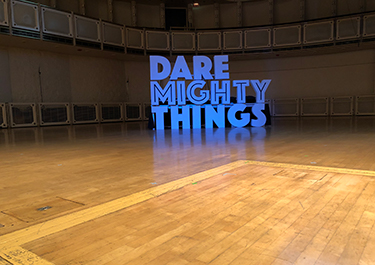 Tech innovation conference Dare Mighty Things hit Chicago yesterday, presenting a day of rapid-fire presentations in the home of the Chicago Symphony Orchestra on Michigan Avenue. Read on to get next steps for blockchain and humanity’s life on Mars, as well as game changers in high-speed transportation, mind-reading, transhumanism and more.
Tech innovation conference Dare Mighty Things hit Chicago yesterday, presenting a day of rapid-fire presentations in the home of the Chicago Symphony Orchestra on Michigan Avenue. Read on to get next steps for blockchain and humanity’s life on Mars, as well as game changers in high-speed transportation, mind-reading, transhumanism and more.
1. Blockchain is “a newer, sexier version of the problem.”
David Schwartz, CTO, Ripple, presented “The Future Of Digital Currency – Building The Internet Of Value.” While he’s passionate about how blockchain has reduced the friction of payments, both domestically and globally, he feels the technology still has a way to go.
“We’ve created a newer, sexier version of the problem we had all along,” he said. “We created more systems that don’t talk to each other.”
To combat this, Ripple has created RippleNet, a modern global payment infrastructure. This combines digital assets and Interledger protocol payments to create what Schwartz calls “the Internet of Value.”
Things got lively when Schwartz opened up the floor to questions. Speaking on the nature of moving money around, he said, “We get paid twice a month. Why? Why don’t they just stream money at you constantly?” which drew laughs from the crowd. “It’s because payments are expensive.”
Schwartz was asked whether the cryptocurrency craze was bad for blockchain. “It was good but now we have what we call the bedbug problem,” he said, explaining that new, unregulated tech directly attached to money brought back antiquated forms of fraud. He termed cryptocurrency, “The most volatile asset we’ve seen in a century.”
2. Will we need food on Mars or not?
Naveen Jain, founder and CEO of Viome, founder of Moon Express and a member of the X-Prize Board presented “The Future Of Health, AI & Moonshot Thinking.” He began his remarks with a bold assertion and challenge: “This planet will be just fine after the humans die. Don’t worry about the planet. Worry about humanity.”
Humanity’s future, Jain said, depends on its eventual migration to either the moon or Mars – and eventually beyond. He said Mars is preferable since if an asteroid wiped out the Earth, the moon would be lost as well. So, the question becomes: How do we grow food on Mars?
Jain feels this is the wrong question, and that we should be asking ourselves why we need to eat food. He said humans can take a cue from plants and derive what they need from a planet’s atmosphere. Jain pointed out that oxygen is free and abundant and asked, “What if energy and food were the next air?”
Later in the day, Lisa Dyson, founder and CEO of Kiverdi, immediately countered this in her talk, “The Future of Sustainability – Converting CO2 to Food Sources.” She stated humanity will need food on Mars and that this will come down to recycling the carbon dioxide people exhale. Dyson proposes a closed-loop carbon cycle in which single-celled organisms, or microbes, grow food from exhaled carbon.
This has applications beyond colonizing Mars. Dyson pointed out that “on Earth we have a carbon problem” as it’s affecting our ozone layer. She laid out the potential environmental impact of using microbes to make food “in hours rather than months,” which will be useful in feeding the 10 billion people projected to inhabit Earth by 2050. Agriculture, Dyson pointed out, uses a lot of space – 50 percent of American land is used for animal-based agriculture. Probiotic agriculture, she said, uses 10,000 times less land and 2,000 times less water.
Not everyone is looking at Mars as humanity’s future home. Bobak Ferdowsi with the NASA Jet Propulsion Laboratory presented “NASA’s Upcoming Search for Life on Europa (Jupiter’s Moon).” Europa, he pointed out, has a lack of craters, demonstrating its stability compared to, for example, our moon, and its ridges demonstrate plate tectonics. It’s theorized that it has oceans beneath its surface but at present there’s no way to measure how deep they are. So NASA is working on a satellite deployment as well as a lander mission to learn more about Europa.
“Beyond the planet Earth we have no other data point for life,” he said. “It’s a positive, optimistic time to look for life in the universe around us.”
3. We need a transportation revolution.
Anita Sengupta, SVP of Virgin Hyperloop One, closed Dare Mighty Things presenting on “Hyperloop: The Future Of Transportation.” Hyperloop is a high-speed form of transportation in which train-like cars move through vacuum-sealed tubes, which could greatly increase the speed with which people travel through the U.S. and beyond.
Sengupta pointed out that transportation today is not keeping up with demand, and when we move to improve it we look at bigger highways, more airlines and more trucks, but these are old technologies. She also pointed out that while air travel is faster than travelling on land, it’s time consuming to engage in overall. “We need a transportation revolution.”
Of Hyperloop, Sengupta boasted that its elimination of aerodynamic drag will allow for extremely high-speeds – potentially as high as 760 miles-per-hour – while still accelerating and decelerating at rates comfortable for passengers. It will allow for on-demand departures direct to destinations.
4. Our understanding of now is getting longer.
Alexander Rose, managing director of The Long Now Foundation, presented “The 10,000 Year Clock & Long Term Thinking” – an ambitious project that seeks to build Clock of the Long Now; a giant clock designed to keep time for 10,000 years. The foundation and clock are based on the idea of “the long now”; a term coined by legendary musician and producer Brian Eno. Eno, Rose said, noted that in referring to now, people generally mean the five-minute span of time they’re currently occupying. The long now stretches the concept of the present out a lot further than that.
“We could look at ourselves as at the end of a 10,000 year human story, but if we look at ourselves as in the middle of a 20,000 year human story, we might act differently,” Rose said. He pointed to a project such as the Sagrada Família in Spain, a beautiful church being built over the course of decades, as an example of humanity building something in line with the idea of the long now. An initial version of the 10,000 Year Clock is being built in a mountain in Texas and the final version will be built in Nevada.
5. Mind-reading may arrive this century.
In an onstage interview with Forbes Science Editor Alex Knapp, Ariel Garten, founder of InteraXon, joked that her company “dares mindy things.” InteraXon has created Muse; a brain-sensing headband designed to help people meditate. It uses four EEG sensors and detects when a person’s mind wanders during meditation, correcting this. Garten, who was previously a practicing psychotherapist, tracked meditation experts during meditation to create the algorithm behind Muse.
Asked by an audience member what this project taught her about her own mind, Garten admitted she’d never been able to meditate before using Muse and compared the first time she did so to hearing a love song on the radio for the first time after falling in love. Asked how her technology may expand in the future, Garten speculated that we’re 50 years away from being able to read people’s thoughts.
6. Animals may not be the only ones with exoskeletons soon.
Dare Mighty Things kicked off with a presentation by Homayoon Kazerooni, founder and CEO of SuitX, presenting “The Future Of Bionics – Building Exoskeletons That Can Enhance Human Potential”; featuring exoskeletons his team has developed for medical and industrial use. SuitX can be used to combat knee and back injuries for those in physically stressful job roles, such as nurses or soldiers, and to help paralyzed people walk again or for the first time. Kazerooni’s aim is to make his exoskeletons “low cost and accessible.” He stated that his suits currently cost $12,000 to manufacture but that his company aims to get that down to $5,000 by Q1 2019.
7. Robots can serve drinks.
Presenting on “The Future Of Robotics,” Ian Bernstein, founder of Misty Robotics and Sphero, brought out his robot Misty – a small, white robot that looked much like a toy – and placed it onstage before stating, “My goal is to put a robot in every home or office.” To get there, he is following four rules of personal robots; that they must be useful, familiar, forge an emotional connection with the user and be multipurpose. Bernstein complained that unfair expectations are placed on the robotics industry due to how robots are depicted in science fiction. Misty never did anything onstage but a video did show her serving drinks at a party.
Click here to get full coverage of Dare Mighty Things 2017!
 Add CompTIA to your favorite RSS reader
Add CompTIA to your favorite RSS reader

